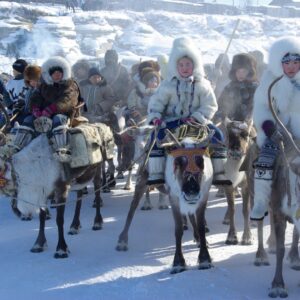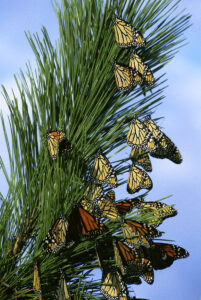Monarch butterfly migration is one of the most remarkable natural phenomena in the world. Each year, millions of monarch butterflies embark on a long journey from their breeding grounds in North America to their overwintering sites in central Mexico and coastal California. This migration is unique because it spans multiple generations of butterflies. The journey begins in late summer and early fall, with monarchs traveling thousands of miles to reach their winter habitats. In spring, the butterflies start their return trip northward, laying eggs along the way, which hatch into caterpillars and eventually metamorphose into the next generation of butterflies.
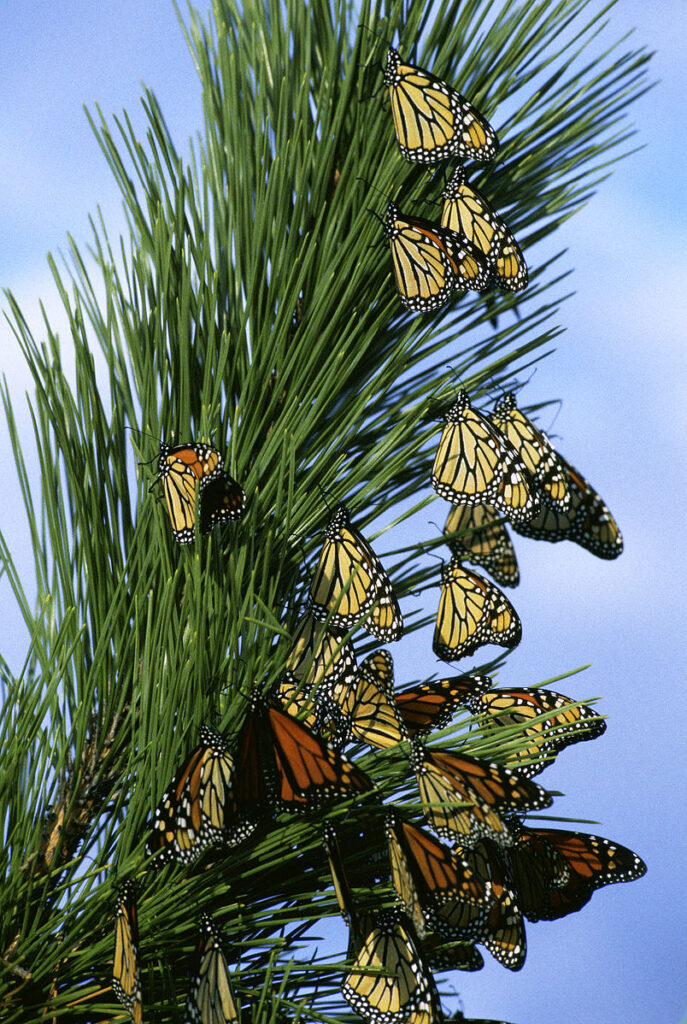 Pin
Pin Image from Wikicommons
The migration of monarch butterflies is not only a breathtaking spectacle but also an important ecological event. It serves as a key indicator of environmental health. Monarchs rely on specific habitats and plants, such as milkweed, for their survival. The presence and health of these butterflies can reflect the broader state of the ecosystem. Their migration supports biodiversity by promoting the growth of milkweed and other nectar plants, which are crucial for many other species.
The monarch migration has cultural and educational significance. It is celebrated in various traditions, particularly in Mexico, where the arrival of the butterflies coincides with the Day of the Dead celebrations. This natural event also provides valuable opportunities for scientific research and environmental education, helping to raise awareness about conservation issues and the importance of protecting natural habitats.
Table of Contents
Migration Routes and Distances
 Pin
Pin Image from Wikicommons
Monarch butterflies undertake one of the longest migrations of any insect species, traveling up to 3,000 miles from their breeding grounds in North America to their overwintering sites in central Mexico and coastal California. There are two primary migration routes:
- Eastern Population: This group of monarchs migrates from the eastern United States and Canada to the oyamel fir forests in the mountains of central Mexico. The journey can span up to 3,000 miles and takes several months to complete.
- Western Population: These monarchs travel from the western United States, particularly from areas west of the Rocky Mountains, to coastal California. Their overwintering sites are typically located in eucalyptus and pine groves along the Pacific coast.
The migration is a multi-generational journey. The butterflies that start the migration in the fall are not the same individuals that complete the return trip in the spring. Instead, it takes about four to five generations of monarchs to complete the entire migratory cycle.
The Migration of Monarch Butterflies is Fraught with Numerous Challenges
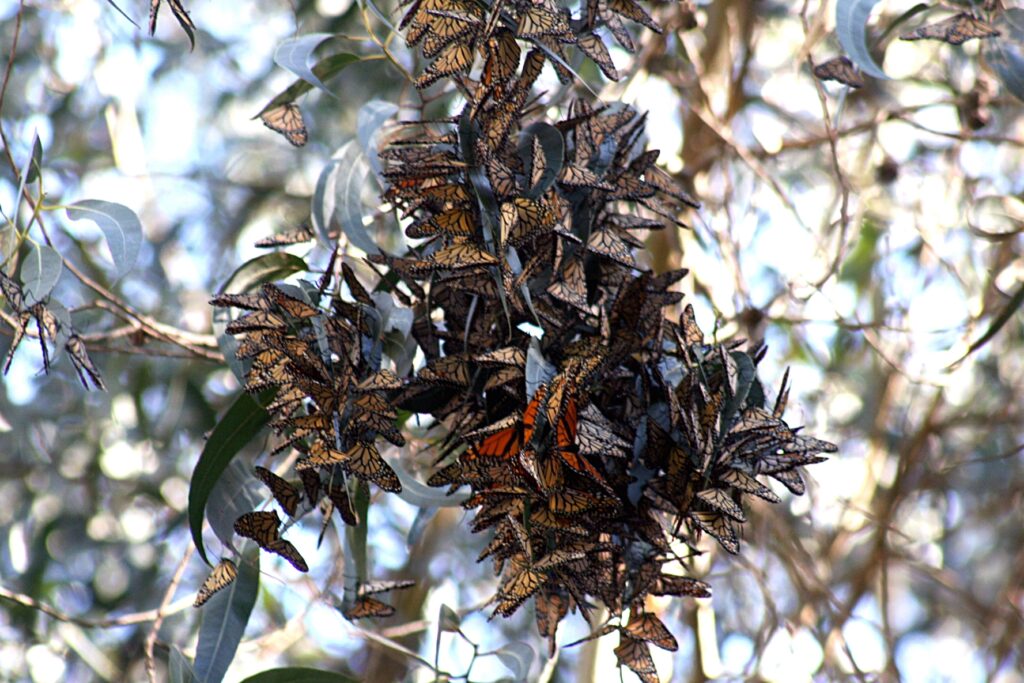 Pin
Pin Image Wikicommons
Climate Change: Changes in climate patterns can disrupt the timing of migration and the availability of resources. Unseasonal weather events, such as early frosts or prolonged droughts, can adversely affect the butterflies’ ability to find food and suitable breeding sites.
Predation and Disease: Monarchs face natural predators, including birds, spiders, and ants. Additionally, they are susceptible to diseases caused by parasites and pathogens, which can weaken or kill them during their journey.
Environmental Hazards: Monarchs must navigate various environmental hazards, such as storms, strong winds, and extreme temperatures. These conditions can lead to physical exhaustion, injury, or death.
Human Activities: Pesticide use in agricultural areas can be lethal to monarchs. Light pollution and vehicle collisions also pose risks during their migration.
Despite these challenges, the monarch butterfly migration remains a resilient and awe-inspiring natural event. Conservation efforts, such as planting milkweed and nectar plants, protecting overwintering sites, and reducing pesticide use, are crucial to ensuring the survival of this incredible journey.
Why Monarch Butterflies Cover Trees
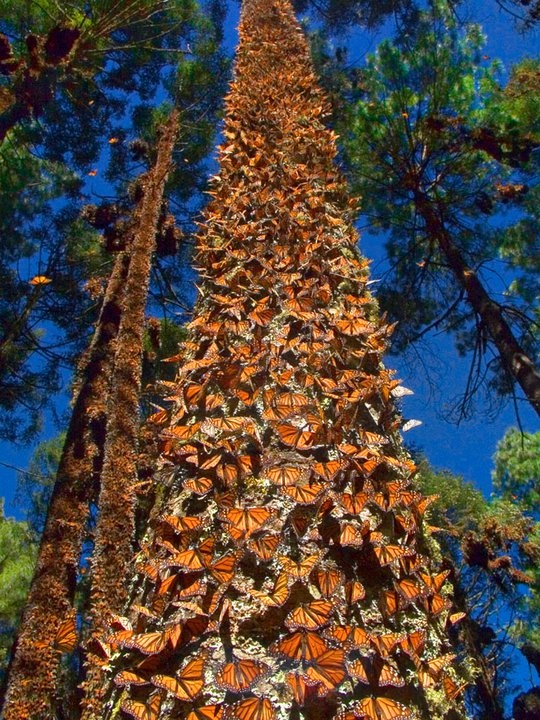 Pin
Pin Image by nytimes.com via Pinterest
Biological and Environmental Reasons
Monarch butterflies cover trees during their migration primarily for survival and conservation of energy. This behavior is most evident during their overwintering period in the oyamel fir forests of central Mexico and the coastal groves of California.
- Temperature Regulation: Monarchs cluster together on trees to maintain a stable temperature. The dense clustering helps them stay warm during the cold winter months. The microclimate created by the trees provides a buffer against extreme temperatures, ensuring that the butterflies do not freeze.
- Humidity Control: The trees in their overwintering sites, such as the oyamel firs, maintain a high humidity level, which is crucial for the butterflies. High humidity prevents the monarchs from drying out and helps them conserve their fat reserves, which are essential for their survival during the winter when they do not feed.
- Protection from Predators and Weather: Clustering on trees offers protection from predators and harsh weather conditions. The dense foliage and branches provide a physical barrier against rain, wind, and potential predators.
Role of Trees in Their Lifecycle
Trees play a vital role in the lifecycle of monarch butterflies, particularly during their overwintering phase:
- Overwintering Habitat: The oyamel fir forests in Mexico and the eucalyptus and pine groves in California are critical overwintering habitats for monarchs. These trees provide the necessary microclimate conditions that allow the butterflies to survive the winter months.
- Resting and Roosting Sites: During migration, monarchs use trees as resting and roosting sites. These stops are essential for the butterflies to rest and recover energy before continuing their long journey. The availability of suitable trees along their migration route is crucial for their successful migration.
- Environmental Cues: Trees and the surrounding environment provide important cues for monarchs. The butterflies use environmental signals such as temperature and daylight changes to time their migration and overwintering behaviors. The presence of specific tree species in their overwintering sites is part of these environmental cues.
- Conservation Efforts: Protecting the trees in monarch overwintering sites is a key focus of conservation efforts. Deforestation and habitat destruction pose significant threats to these critical habitats. Conservation initiatives aim to preserve and restore these tree habitats to ensure the survival of monarch populations.
Understanding the relationship between monarch butterflies and their tree habitats highlights the importance of preserving these environments. Efforts to protect and restore these habitats are essential for the continued survival of this remarkable species.
The Spectacle of Trees Cloaked in Butterflies
 Pin
Pin Image from Pinterest
The trees are not just covered in leaves but are adorned with thousands of beautiful, fluttering butterflies. This breathtaking sight is a natural wonder, often described as a living, breathing tapestry of color. The butterflies, predominantly monarchs, cluster together in such dense numbers that they appear to transform the trees into shimmering, orange-and-black mosaics. As the sun rises, the butterflies warm up and take flight, creating a mesmerizing, almost magical scene as they flutter around in search of nectar.
This phenomenon is most famously observed in the monarch butterfly sanctuaries of Mexico. The Monarch Butterfly Biosphere Reserve, a UNESCO World Heritage site located in the Trans-Mexican Volcanic Belt, is one of the prime locations. Here, millions of monarchs migrate each year from Canada and the United States to escape the cold winters.
Other notable locations include:
- Sierra Chincua Sanctuary: Known for its accessibility and the sheer number of butterflies.
- El Rosario Sanctuary: The largest and most visited sanctuary, offering guided tours and educational programs.
- Piedra Herrada Sanctuary: A lesser-known but equally stunning site, providing a more tranquil experience.
Impact on Local Ecosystems
Monarch butterflies play a crucial role in their ecosystems. Their presence indicates a healthy environment, as they require specific conditions to thrive. The butterflies contribute to the biodiversity of their habitats, supporting various plant and animal species. Their larvae feed on milkweed, which is toxic to many predators, thus controlling the plant’s growth and maintaining a balance in the ecosystem. Additionally, the butterflies themselves serve as prey for birds and other insects, forming an integral part of the food web.
Importance of Monarch Butterflies in Pollination
Monarch butterflies are vital pollinators. As they travel from flower to flower in search of nectar, they inadvertently transfer pollen, facilitating the reproduction of many flowering plants. This process is essential for the production of fruits and seeds, which in turn support a wide range of wildlife. The decline in monarch populations can lead to reduced pollination, affecting plant diversity and the animals that depend on these plants for food and shelter. Therefore, protecting monarch butterflies is not just about preserving a beautiful species but also about maintaining the health and stability of entire ecosystems.
Current Threats to Monarch Butterflies
Monarch butterflies face several significant threats that have led to a dramatic decline in their populations over recent decades:
- Habitat Loss: The conversion of grasslands to agricultural lands and urban development has reduced the availability of milkweed, the only plant on which monarchs lay their eggs. Logging and thinning of forests in their overwintering sites in Mexico and California also contribute to habitat loss.
- Pesticides and Herbicides: The widespread use of pesticides and herbicides, particularly neonicotinoids, has been detrimental to monarch populations. These chemicals not only kill the insects directly but also reduce the availability of milkweed and other nectar plants.
- Climate Change: Changes in climate patterns affect the timing and success of monarch migrations. Extreme weather events, such as droughts and storms, can destroy habitats and disrupt the butterflies’ life cycle.
- Pollution: Air and water pollution can degrade the quality of the habitats that monarchs rely on, further stressing their populations.
Initiatives to Protect Their Habitats
Several initiatives are underway to protect and restore monarch butterfly habitats:
- Habitat Restoration: Organizations like the National Wildlife Federation and the Xerces Society are working to restore habitats by planting milkweed and other native plants. These efforts are crucial for providing breeding and feeding grounds for monarchs.
- Community Engagement: Programs such as the Monarch Joint Venture and the Butterfly Heroes program encourage communities to create monarch-friendly habitats in gardens, schools, and public spaces.
- Policy and Advocacy: Conservation groups are advocating for stricter regulations on pesticide use and promoting pollinator-friendly farming practices. These policies aim to reduce the harmful impacts of chemicals on monarch populations.
- Research and Monitoring: Continuous research and monitoring efforts help track monarch populations and assess the effectiveness of conservation strategies. Community science projects like the Western Monarch Thanksgiving Count involve the public in data collection.
Monarch Butterflies in Folklore and Traditions
Monarch butterflies hold a special place in various cultures and traditions:
- Mexican Traditions: In Mexico, monarch butterflies are associated with the Day of the Dead. It is believed that the butterflies carry the souls of deceased ancestors back to visit their loved ones.
- Native American Folklore: Many Native American tribes view monarch butterflies as symbols of transformation and renewal. They are often featured in stories and ceremonies that celebrate life cycles and change.
Historical Accounts of Their Migrations
The migration of monarch butterflies has been documented for centuries:
- Early Observations: Indigenous peoples and early settlers in North America noted the large numbers of monarchs migrating south in the fall. These migrations were often seen as natural wonders.
- Scientific Documentation: In the 20th century, scientists began to study monarch migrations more systematically. The discovery of their overwintering sites in Mexico in the 1970s was a significant milestone in understanding their migratory patterns.
Scientific Studies and Research
Recent studies have provided valuable insights into monarch butterfly biology and conservation:
- Genetic Research: Advances in genetic research have helped scientists understand the genetic diversity and adaptability of monarch populations. This information is crucial for developing effective conservation strategies.
- Migration Patterns: Studies using tracking technology have revealed detailed information about the migration routes and stopover sites used by monarchs. This data helps identify critical habitats that need protection.
Best Times and Places to See Monarch Butterflies Covering Trees
Witnessing the awe-inspiring sight of monarch butterflies covering trees is a magical experience. Here are the best times and places to see this phenomenon:
- Mexico: The most famous overwintering sites are in the Monarch Butterfly Biosphere Reserve in the Mexican states of Michoacán and Estado de México. The best time to visit is between late October and early March, with the peak viewing period being in January and February.
- California: In the United States, monarchs also overwinter along the California coast. Notable sites include Pacific Grove, Pismo Beach, and the Natural Bridges State Beach in Santa Cruz. The best time to visit these sites is from late October to February.
- Texas: During their migration, monarchs can be seen in large numbers in Texas, particularly in the Hill Country and along the Gulf Coast. The best times to observe them are during their southward migration in October and their northward migration in March and April.




















